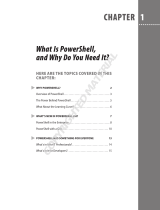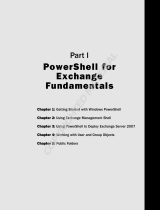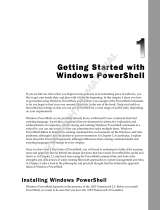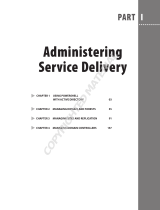
Exchange Replica Smart Copies Might Require Manual Soft Recovery
Verification and soft recovery of Exchange replica Smart Copies are performed on the replication partner. Verification consists of two
steps: the actual verification, and the soft recovery, where the database is brought from a dirty shutdown state to a clean
shutdown state. Soft recovery requires read-write access to the database. In the case of replica Smart Copies, this process requires
some additional planning.
You can give read-write access to the Smart Copy in the following ways:
• Promote the replica set to a recovery volume
• Clone the replica, which creates a new volume
A promoted replica will remain promoted only while verification is running. As soon as verification completes, the replica is demoted again,
and replication can resume. However, any changes made to the replica during the soft recovery phase of replication are discarded when
the replica is demoted, because replication for any given volume is one way. No mechanism is available for replicating changes made on
the replication partner back to the original volume.
If you want to mount a replica Smart Copy of an Exchange database on your Exchange server (for example, during a Restore as New
operation in ASM/ME), you must manually run soft recovery on that Smart Copy first, even though soft recovery was run during the
verification process. You can perform a manual soft recovery by using the Exchange Eseutil utility.
This restriction applies only to replica Smart Copies. Snapshots and clones do not require this extra step.
Deleting a VSS Snapshot Occasionally Results in an Error Condition in the
Group Manager Due to iSCSI Log Off Failure
Occasionally, when the Microsoft Volume shadow Copy Service (VSS) receives a request to delete a VSS snapshot from the EqualLogic
VSS Provider, a Requested target not found error is displayed in the Group Manager, even though the snapshot has been
deleted. You will most likely see this error message after running backups using third party backup software.
In normal operations, the EqualLogic VSS Provider first logs off the iSCSI session for the snapshot, then offlines and deletes the snapshot.
However, when the iSCSI log off fails, VSS continues to delete the snapshot because the iSCSI session log off failure is regarded as
insignificant and is ignored.
When an iSCSI logoff session fails, the iSCSI initiator attempts to reconnect to the target. When this occurs, a Requested target
not found error is displayed in the Group Manager, as shown in the following figure.
Figure 1. Error Message in Group Manager Event Log
Information about this error also appears in the HIT/ME error log file. For example:
23-Sep-16 15:31:37.843|VSS|2016|8040||INFO|CEqlVssProvider::OnLunEmpty|645|@@@@
IVssHardwareSnapshotProvider::OnLunEmpty, DebugFlag 0x8 @@@@
23-Sep-16 15:31:37.843|VSS|2016|8040||INFO|CEqlVssProvider::OnLunEmpty|645|Logging Out
from targetName \\?\mpio#disk&ven_eqlogic&prod_100e-00&rev_8.0_#....
23-Sep-16 15:32:07.421|VSS|2016|8040||ERROR|CEqlVssProvider::OnLunEmpty|672|Error
0xEFFF0040 logging out from \\?\mpio#disk&ven_eqlogic&prod_100e-00&rev_8.0_#....
Because this error does not impact the functionality of the storage system, regard the Requested target not found error as
informational only. No further action is required.
Support Resources
The following resources are available for HIT/ME:
• Installation Kit
• Related Documentation
Dell EqualLogic Host Integration Tools for Microsoft Edition Version 5.3 Release Notes
11
















